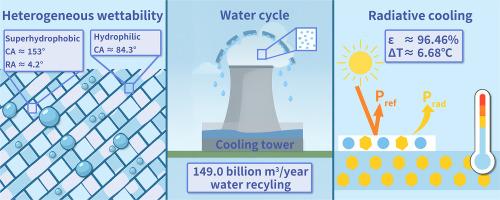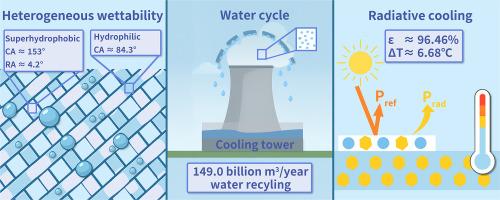Bioinspired polyethylene/boron nitride woven mesh integrating heterogeneous wettability and radiation cooling for water recycling of cooling tower
IF 12.4
1区 环境科学与生态学
Q1 ENGINEERING, ENVIRONMENTAL
引用次数: 0
Abstract
Industrial cooling towers, consuming ∼50 % of global industrial water, incur significant losses via evaporation, drift, and blowdown. To address this challenge, we developed a melting blending and extrusion-drawing method to fabricate spider-web inspired woven mesh based on polyethylene/boron nitride composites. The bioinspired mesh integrates heterogeneous wettability with radiative cooling to efficiently harvest water from the cooling tower. The bioinspired woven mesh exhibited a strong mid-infrared emissivity of 96.46 % and a temperature reduction of 6.68 °C is achieved. The micro/nanostructure-induced heterogeneous wettability synergized with radiative cooling to enhance droplet nucleation and growth, boosting water recycling efficiency by 54.67 % compared to conventional meshes. When applied to the water recycling of the cooling tower, the bioinspired woven mesh achieved a water recycling rate of 13.58 kg m⁻² h⁻¹ with a recovery efficiency of 71.46 %. Furthermore, the water recycling efficiency and material properties of the bioinspired woven mesh remained stable after 30 days of outdoor testing and 72 h of continuous UV irradiation of 0.5 W cm⁻², ensuring long-term durability for sustainable water recovery in industrial applications. Critically, global implementation of this spider-web-inspired woven mesh in industrial cooling towers could conserve ∼149.0 billion m³ of water annually. This rapid, efficient strategy addresses key challenges in cooling tower water recycling through synergistic heterogeneous wettability and radiative cooling.


集非均相润湿性和辐射冷却于一体的仿生聚乙烯/氮化硼编织网用于冷却塔水循环利用
工业冷却塔消耗全球约50%的工业用水,通过蒸发、漂移和排污造成重大损失。为了解决这一挑战,我们开发了一种熔融混合和挤压拉伸方法来制造基于聚乙烯/氮化硼复合材料的蛛网编织网。仿生网将非均匀润湿性与辐射冷却相结合,有效地从冷却塔中收集水。该仿生编织网的中红外发射率高达96.46%,温度降低了6.68℃。微纳米结构诱导的非均匀润湿性与辐射冷却协同作用,促进液滴成核和生长,与传统网相比,水循环效率提高了54.67%。应用于冷却塔的水循环时,生物编织网的水循环率为13.58 kg m⁻²h⁻¹,回收率为71.46%。此外,经过30天的户外测试和72小时的0.5 W cm(⁻²)紫外线照射后,生物编织网的水循环效率和材料性能保持稳定,确保了工业应用中可持续水回收的长期耐用性。至关重要的是,在全球范围内,在工业冷却塔中实施这种以蜘蛛网为灵感的编织网,每年可以节约约1490亿立方米的水。这种快速、有效的策略通过协同的非均质润湿性和辐射冷却解决了冷却塔水循环中的关键挑战。
本文章由计算机程序翻译,如有差异,请以英文原文为准。
求助全文
约1分钟内获得全文
求助全文
来源期刊

Water Research
环境科学-工程:环境
CiteScore
20.80
自引率
9.40%
发文量
1307
审稿时长
38 days
期刊介绍:
Water Research, along with its open access companion journal Water Research X, serves as a platform for publishing original research papers covering various aspects of the science and technology related to the anthropogenic water cycle, water quality, and its management worldwide. The audience targeted by the journal comprises biologists, chemical engineers, chemists, civil engineers, environmental engineers, limnologists, and microbiologists. The scope of the journal include:
•Treatment processes for water and wastewaters (municipal, agricultural, industrial, and on-site treatment), including resource recovery and residuals management;
•Urban hydrology including sewer systems, stormwater management, and green infrastructure;
•Drinking water treatment and distribution;
•Potable and non-potable water reuse;
•Sanitation, public health, and risk assessment;
•Anaerobic digestion, solid and hazardous waste management, including source characterization and the effects and control of leachates and gaseous emissions;
•Contaminants (chemical, microbial, anthropogenic particles such as nanoparticles or microplastics) and related water quality sensing, monitoring, fate, and assessment;
•Anthropogenic impacts on inland, tidal, coastal and urban waters, focusing on surface and ground waters, and point and non-point sources of pollution;
•Environmental restoration, linked to surface water, groundwater and groundwater remediation;
•Analysis of the interfaces between sediments and water, and between water and atmosphere, focusing specifically on anthropogenic impacts;
•Mathematical modelling, systems analysis, machine learning, and beneficial use of big data related to the anthropogenic water cycle;
•Socio-economic, policy, and regulations studies.
 求助内容:
求助内容: 应助结果提醒方式:
应助结果提醒方式:


